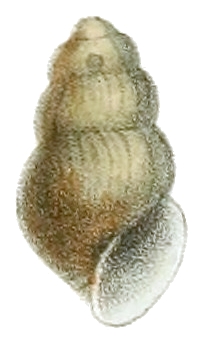Cylindrical lioplax
| Cylindrical lioplax | |
|---|---|
 |
|
| An 1870 drawing of the shell of Lioplax cyclostomaformis | |
| Scientific classification | |
| Kingdom: | Animalia |
| Phylum: | Mollusca |
| Class: | Gastropoda |
| (unranked): | clade Caenogastropoda informal group Architaenioglossa |
| Superfamily: | Viviparoidea |
| Family: | Viviparidae |
| Subfamily: | Lioplacinae |
| Genus: | Lioplax |
| Species: | L. cyclostomaformis |
| Binomial name | |
|
Lioplax cyclostomaformis I. Lea, 1841 |
|
The cylindrical lioplax, scientific name Lioplax cyclostomaformis, is a species of freshwater snail with gills and an operculum, an aquatic gastropod mollusk in the family Viviparidae.
This species is endemic to the United States.
The shell is elongate, reaching about 28 millimeters (mm) (1.1 inches (in)) in length. Shell color is light to dark olivaceous-green externally, and bluish inside of the aperture (shell opening).
The cylindrical lioplax is distinguished from other viviparid (eggs hatch internally and the young are born as juveniles) snails in the Mobile River Basin by the number of whorls, and differences in size, sculpture, microsculpture, and spire angle.
This species is endemic to the United States.
No other species of lioplax snails are known to occur in the Mobile River Basin (see Clench and Turner, 1955 for a more detailed description).
Collection records for the cylindrical lioplax exist from the Alabama River (Dallas County, Alabama), Black Warrior River (Jefferson County, Alabama) and tributaries (Prairie Creek, Marengo County, Alabama; Valley Creek, Jefferson County, Alabama); Coosa River (Shelby, Elmore counties, Alabama) and tributaries (Oothcalooga Creek, Bartow County, Georgia; CoahuIla Creek, Whitfield County, Georgia; Annuchee Creek, Floyd County, Georgia; Little Wills Creek, Etowah County, Alabama; Choccolocco Creek, Talladega County, Alabama; Yellowleaf Creek, Shelby County, Alabama); and the Cahaba River (Bibb, Shelby counties, Alabama) and its tributary, Little Cahaba River (Jefferson County, Alabama).
...
Wikipedia

